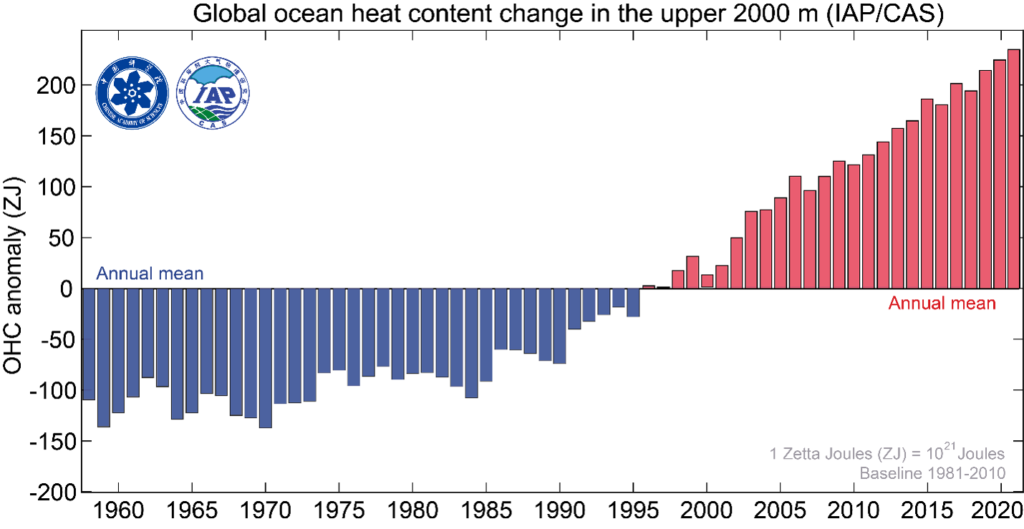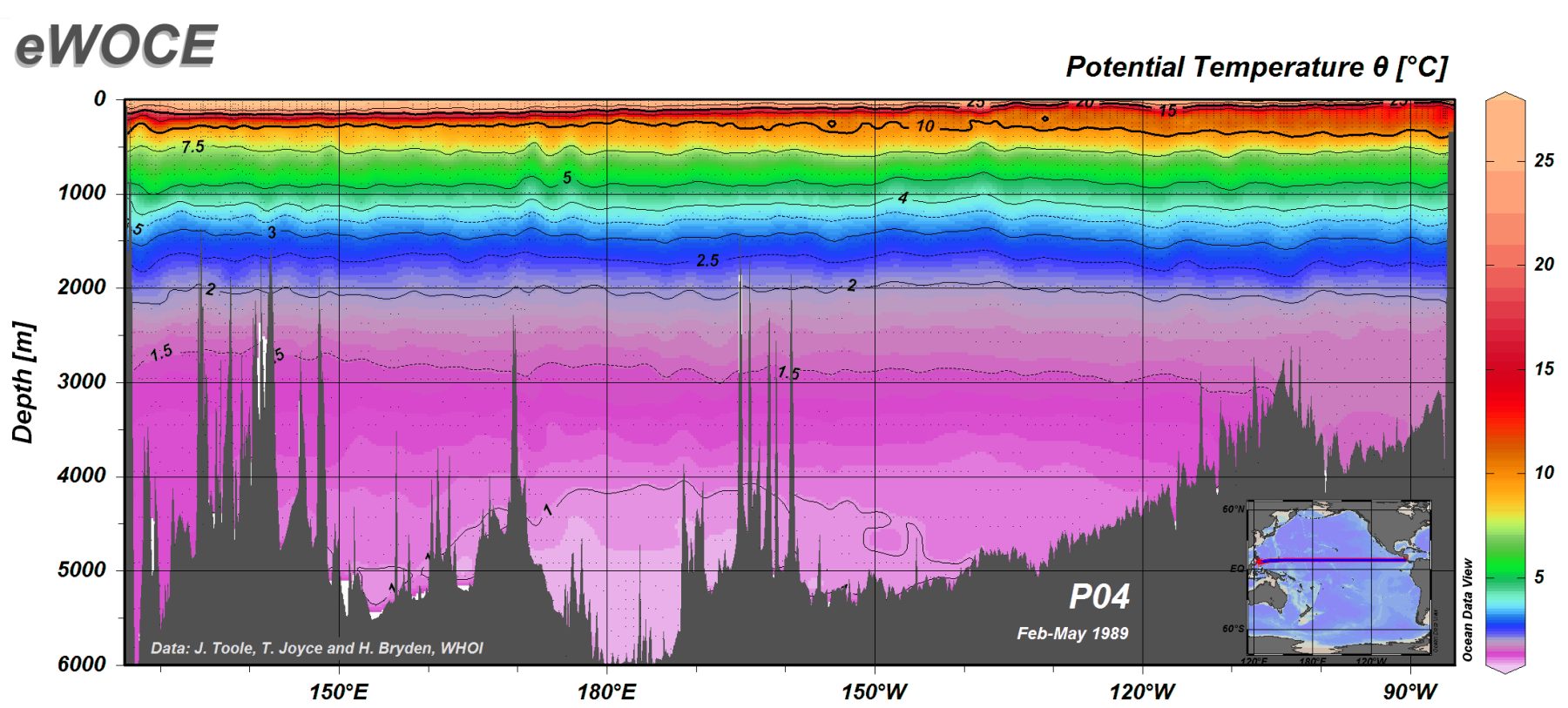In order of priority, the recent causes of climate warming are:
Greenhouse Gases Less pollution Ocean Stratification Feedbacks Urban Heat Island effect
Greenhouse Gases: the main cause of climate warming:
Most climate scientists, but not all, believe that carbon dioxide (CO2) is the greenhouse gas mainly responsible for climate warming. Carbon dioxide greenhouse gas is responsible for the earth being temperate — staying at a fairly constant level of about 280 Celsius degrees during historical times up until perhaps two hundred years ago. However, with the constantly increasing use of fossil fuels, CO2 has been increasing each year, and as I write it stands at 423 parts per million. CO2 is a very long-lived, weak greenhouse gas, given a value of only 1 in comparisons, but tons and tons of it are emitted because of human actions, much more than any other greenhouse gas. (It is worth noting that natural emissions and sinks for CO2 vary, and are much larger than the human contribution, but for millennia these have been, on average, in balance.)
Because so much CO2 is already in the atmosphere, some dissident climate scientists have argued that the additional CO2 has had only a weak or negligible effect. Most climate scientists, however, disagree with this. Additionally, if one does not believe in the CO2 hypothesis, one must come up with another cause of climate warming. Many other theories have been put forward, but thus far nobody has made a convincing case. Studies of the sun have shown that although the sun dimmed slightly during the little ice age of the late 13 to early 15th centuries, solar radiation of all types, and other radiation from space has not changed much is recent centuries. The clearing of forests, because it decreased the sun’s absorption, has historically probably had a long term cooling effect 1, and with the exception of the recent eruption of the Hunga-Tonga eruption in 2022, volcanos have not increased warming. Sea surface temperatures did not begin warming until 1930. So that leaves greenhouse gases, and especially CO2, as the only plausible drivers of global warming. See a detailed discussion of greenhouse gases on this page2 and the following pages.
Methane (CH4) is by far the second most influential greenhouse gas. The number of molecules in the atmosphere is 1/200th that of CO, but methane has a greenhouse effect that is approximately 140 times more powerful than CO2 by weight when emitted, 80 after twenty years and 30 after 100 years. My studies suggest that its greenhouse effect is larger than the official number. The largest human-caused sources of methane are fossil fuels and bovines (cattle, water buffalo, etcetera), all of which are increasing. Natural emissions of methane are increasing with hotter temperatures.
Nitrous Oxide (N2O) is also a powerful greenhouse gas with a comparison value of 300 by weight when emitted and perhaps 270 after 100 years. The number of molecules in the atmosphere is said to be 1/6 that of methane. But this is also probably an under count. About four-fifths of N2O is from the use of nitrogen fertilizer in agriculture and one-twentieth is from animal dung. Natural emissions of nitrous oxide are rising with increasing temperatures.
Refrigerant gases used today (usually HFCs) have very high greenhouse values, often over 1000 , and they often live for hundreds or thousands of years. In usages such as supermarkets they can leak up to 25% a year, and in homes refrigerant may leak out due to punctures or age or failure to recycle. Warming caused by refrigerant gasses is presently about 2.5% of that from CO2 (source: https://www.fluorocarbons.org/environment/climate-change/atmospheric-concentrations). Legislation has mainly eliminated the refrigerant gases that were destroying the ozone layer, but not those with a high greenhouse effect. In most situations, it as been impractical or impossible to replace HFC’s with low-emission gases. The amount of refrigeration gases emitted is increasing at the fastest rate of any greenhouse gas, multiplying around 4 times since 1990 (source: https://www.ipcc.ch/report/ar6/wg3/downloads/report/IPCC_AR6_WGIII_SPM.pdf).
Despite the glib talk of limiting them, the amount emitted of every greenhouse gas has been growing every year.
Less Pollution has been warming the climate:
The main pollutant affecting the climate has been sulfur dioxide (SO2) followed by carbon particles. The principal historical emitter of both has been coal. Fuel oil also has contained as much as one-half percent sulphur. With the reduced use of coal and the adoption of very low sulphur fuel oil, SO2 and carbon particles have greatly decreased in recent years. In the UK, for example, SO2 emissions have decreased 98% since 1970 (source: https://www.gov.uk/government/statistics/emissions-of-air-pollutants/emissions-of-air-pollutants-in-the-uk-sulphur-dioxide-so2)

Sulfur dioxide and to a lesser extent carbon particles had a double effect on temperature. First, after the SO2 combined with water to form tiny particles of sulfuric acid, these particles reflected the sun, and second the particles seeded clouds which also reflected the sun. Throughout the industrial revolution these effects held down climate warming, and even, as in 1860 to 1880, 1900 to 1920 and 1940 to 1960, caused the climate to cool slightly. In 1980, before recent SO2 reductions, the Intergovernmental Panel on Climate Change (IPCC) estimated that aerosols reduced global temperatures by about 0.4º C. So since 1980, assuming an 80% worldwide reduction, these reductions must have increased world temperatures by 0.32º C, which is equal to more than one-half the entire rise in temperature from 1980 to 2023.
Ocean stratification has increased Climate Warming:
In 2024 all the world’s oceans have reached the hottest temperatures ever.

Since the average temperature of the ocean is 5C — far less than the upper layer — when the top water mixes with the water further down it limits the rise in temperature. (See the graphic below.)
A study published in 2021 in the journal Nature found that world’s oceans have become more stratified each decade as far back as the data goes (to 1970); that is the upper layer of the ocean is not mixing as much with the layers below, and the study found also that the upper layer was getting thicker; that is, more warm water had accumulated there. (https://www.nature.com/articles/s41586-021-03303-x). This is happening, it is believed, because hotter water is less dense and also because the surface layer has become less salty due to glacier and iceberg melt.
Obviously, if the hot upper layer waters are less cooled by lower ocean layers, they will remain hot and get hotter — and since oceans are hotter , land temperatures also become hotter.

Feedbacks from previous warming
Recent studies of clouds have unfortunately found that the warmer temperatures from the first three listed causes are reducing cloud numbers and reflectivity.3 4 If many clouds disappear, at least 4% more solar radiation would reach the earth. According to Climate.gov, a .07% change in solar irradiation (the maximum amount that the sun has varied over the historical record) would result in a 0.1 degree change. Thus a 0.7% change wold result in a temperature change of 1 C, and a 4% change would result in a change 5.7º C (10.3ºF warming)! Many climate models are being updated to predict this!
Warming temperatures are also increasing the rate of nitrous oxide and methane emissions from wetlands and landfills; and they are increasing the rate of melting of the permafrost. If this melting accelerates the methane released, with its very high immediate warming potential, could drive temperatures far higher. This is known as the possible “methane bomb”.
The Urban Heat Island Effect on the temperature people experience:
Most people live in sizable urban areas, but they are 1% of the earth’s surface. The temperature most people experience, as well as the city temperatures reported in the media, reflect the urban heat island effect. Cities have doubled or tripled in size in the last 100 years, and often more, so the heat island effect is much stronger.
It is common knowledge that temperatures are warmer in a city than in the country. Heat island effects are caused by structures trapping heat, and for that reason are bigger at night. The organization Climate Central, in 2023, measured the heat island effect in United States cities that have over 550,000 inhabitants— where 80% of the US population lives. They found no cities (when city areas were weighted by population) with less than a 7.2º F (4.0º C) heat island effect. New York City had a 9.5º F (5.3C) heat island effect. Other studies have found that London is 4.5ºC hotter (8º F) than rural surroundings, and that Central Paris 3ºC (5.4º F) hotter than its suburbs, which are hotter than rural areas.
The land temperatures used by governments are at least 0.1ºC hotter than satellite temperatures, because weather stations today are more frequently in urban areas and near heat sources such as airports Satellite world temperatures are are therefore a better indications of total global warming.
Are we slowing climate warming?
- See my discussion here: How does the destruction of forests affect the climate? ↩︎
- What are the main greenhouse gases, and what effect do they have? ↩︎
- https://e360.yale.edu/features/why-clouds-are-the-key-to-new-troubling-projections-on-warming ↩︎
- https://www.imperial.ac.uk/news/194738/thanks-clouds-climate-simulations-predict-more/ ↩︎